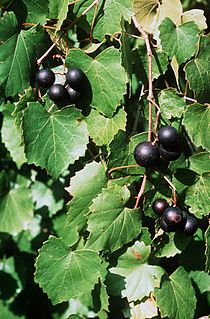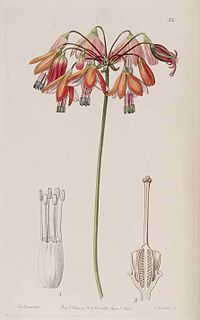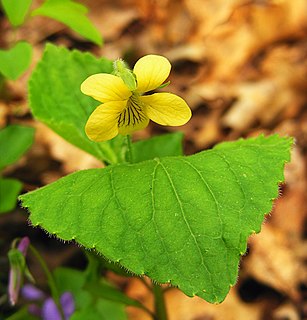
Vitis rotundifolia, or muscadine, is a grapevine species native to the southeastern and south-central United States. The growth range extends from Florida to New Jersey coast, and west to eastern Texas and Oklahoma. It has been extensively cultivated since the 16th century. The plants are well-adapted to their native warm and humid climate; they need fewer chilling hours than better known varieties, and thrive in summer heat.

Campanula rotundifolia, the harebell, Scottish bluebell, or bluebell of Scotland, is a species of flowering plant in the bellflower family Campanulaceae. This herbaceous perennial is found throughout the temperate regions of the northern hemisphere. In Scotland, it is often known simply as bluebell. It is the floral emblem of Sweden where it is known as small bluebell. It produces its violet-blue, bell-shaped flowers in late summer and autumn.

Drosera rotundifolia, the round-leaved sundew or common sundew, is a carnivorous species of flowering plant that grows in bogs, marshes and fens. One of the most widespread sundew species, it has a circumboreal distribution, being found in all of northern Europe, much of Siberia, large parts of northern North America, Korea and Japan but is also found as far south as California, Mississippi and Alabama in the United States of America and in New Guinea.

Bessera is a genus of Mexican plants in the cluster lily subfamily within the asparagus family. It is a small genus of 3 known species of mostly herbaceous flowering plants with corms. They have flowers with petals and petaloid sepals (tepals) with compound pistils.

Cupaniopsis is a genus of about 67 species of trees and shrubs of the soapberry family, Sapindaceae. They grow naturally in New Guinea, New Caledonia, Australia, Torres Strait Islands, Fiji, Samoa, Sulawesi, Micronesia. Many species have been threatened with extinction globally or nationally, with official recognition by the International Union for Conservation of Nature (IUCN) and several national and state governments.

Viola pubescens, commonly called the downy yellow violet, is a plant species of the genus Viola and is classified within the subsection Nudicaules of section Chamaemelanium. It is a widespread North American violet found in rich, mesic woodlands, and sometimes in meadows, from Minnesota and Ontario east to Nova Scotia and south to Virginia. V. pubescens produces two different types of flowers during the season, including chasmogamous flowers in the early spring and cleistogamous flowers summer through fall.
Adenopodia rotundifolia is a species of legume in the family Fabaceae. It is found in Somalia and Tanzania.
Reevesia rotundifolia is a species of flowering plant in the family Malvaceae. It is found only in China. It is threatened by habitat loss.
Ballochia rotundifolia is a species of plant in the family Acanthaceae. It is endemic to Socotra. Its natural habitat is subtropical or tropical dry forests.
Beauprea congesta is a species of plant in the family Proteaceae. It is endemic to New Caledonia.
Blakea rotundifolia is a species of plant in the family Melastomataceae. It is endemic to Ecuador. Its natural habitat is subtropical or tropical moist montane forests.
Guapira myrtiflora is a species of plant in the Nyctaginaceae family. It is found in Colombia, Panama, and Peru.

Helicia is a genus of 110 species of trees and shrubs, constituting part of the plant family Proteaceae. They grow naturally in rainforests throughout tropical South and Southeast Asia, including India, Sri Lanka, Indochina, Peninsular Malaysia to New Guinea and as far south as New South Wales.

Kermadecia is a genus of flowering plants in the family Proteaceae. The genus comprises five species, all endemic to New Caledonia. Its closest relatives are Sleumerodendron and Turrillia, of which the species have once been placed in Kermadecia.
Prestonia rotundifolia is a species of plant in the family Apocynaceae. It is native to Colombia and Ecuador. Its natural habitats are subtropical or tropical dry forests and subtropical or tropical moist lowland forests. It is threatened by habitat loss.
Shorea rotundifolia is a species of plant in the family Dipterocarpaceae. It is a tree endemic to Borneo, where it is confined to Sarawak.

Vitex rotundifolia, the roundleaf chastetree or beach vitex is a species of Vitex that is native to seashores throughout the Pacific. Its range includes continents and islands stretching from India east to Hawaii and from Korea south to Australia. This woody perennial plant typically grows approximately 1 m in height. It has a sprawling growth habit and produces runners that root regularly at nodes. This rooting pattern allows the plant to spread rapidly. At maturity, V. rotundifolia produces blue-purple flowers that are borne in clusters and ultimately yield small brown-black fruits. Its leaves are rounded at the tips with green upper surfaces and silver lower surfaces. While the plant is a seashore obligate, it grows over a wide latitude range. It has been used for medicinal purposes throughout its native range. More recently, it was imported to the eastern United States where it has become a seashore invasive. Control efforts are presently underway to protect the fragile beach dune ecosystem.

Quercus rotundifolia, the holm oak or ballota oak, is an evergreen oak native to the western Mediterranean region, with the majority on the Iberian Peninsula. The species was first described by Jean-Baptiste Lamarck in 1785. It is the typical species of the Iberian dehesa or montado, where its sweet-astringent acorns are a source of food for livestock, particularly the Iberian pig. It has previously been described in the same species as Quercus ilex. Its acorns have been used for human nourishment since the Neolithic era.
Arabis sadina is a species of flowering plant in the family Brassicaceae. It is endemic to Portugal.

Kobuleti Strict Nature Reserve is a protected area in Kobuleti Municipality, Adjara region of Georgia along the Black Sea coast in the northern part of the resort town Kobuleti. Kobuleti Protected Areas were established in 1998 to preserve unique wetland ecosystems recognized by the Ramsar Convention. It is part of the Colchic Rainforests and Wetlands, a UNESCO World Heritage Site.











